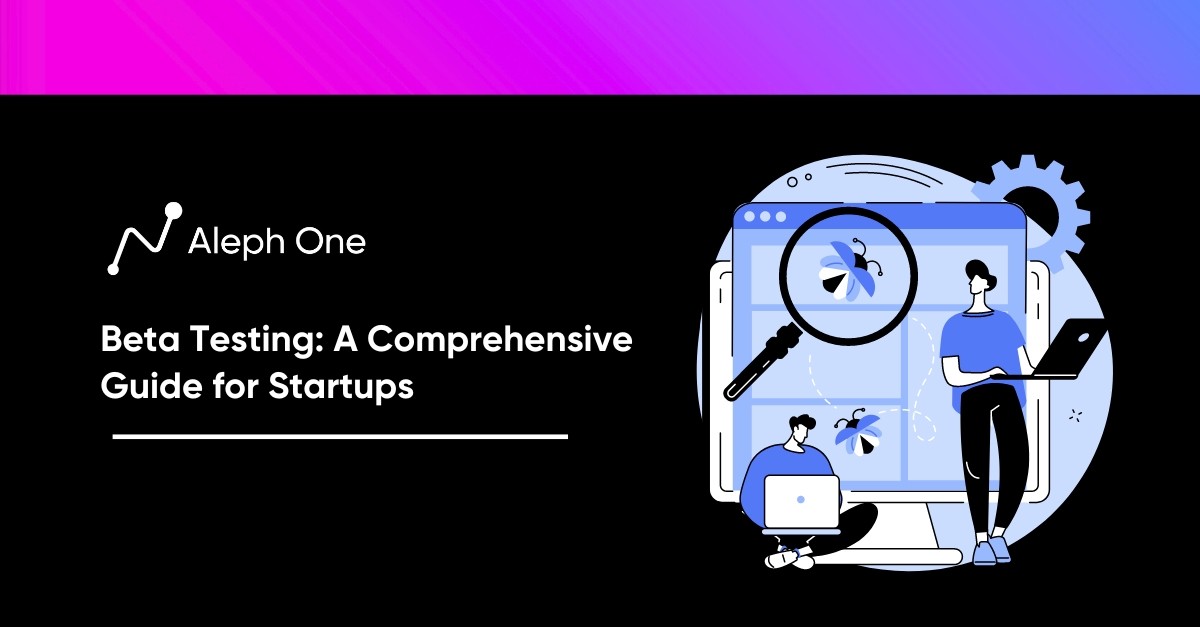Let’s work together to build something amazing. Share your project details and our team will reply to figure out the next steps to your success.

Beta testing has come a long way since its early days as a mere bug detection tool for tech giants like IBM and Microsoft. In the ever-evolving startup landscape, beta testing has morphed into a strategic growth engine, unlocking opportunities for success. Prominent tech pioneers such as Google, Facebook, and Dropbox pioneered the art of building hype around invite-only beta programs and harnessing the power of real customer feedback to fine-tune their products. Taking inspiration from these successes, modern startups have turned beta tests into immersive experiences, incorporating gamification and enthusiastic customer involvement to gain invaluable insights before their official launch. In this comprehensive guide, we dive into the essence of beta testing, from assembling a team of testers to designing interactive and insightful tests, generating buzz, and leveraging feedback to fuel growth. With the right beta testing strategy, startups can wield this secret weapon to accelerate their journey from concept to triumph.

The Origins of Beta Testing: How Startups Have Evolved the Practice
Beta testing has been an integral part of software development for decades. In the early days of tech, companies like IBM and Microsoft relied on beta tests to detect bugs and issues in new products before their official release. Participants were typically customers or industry experts who tested the product in their environments.
Customer Validation & Growth Strategy
Startups have adapted beta testing as a crucial part of their customer validation and growth strategies. Rather than just bug detection, beta tests are now used to gain valuable insights into customer needs, interests, and behaviors. Interactive and engaging beta tests with real customers allow startups to improve their products to match customer needs before launch better.
Invite-only Beta Programs
Prominent tech companies like Google, Facebook, and Dropbox relied on beta tests in their early days. Gmail, Facebook Platform, and Dropbox started as invite-only beta programs that generated buzz, attracted early adopters, and provided feedback to enhance the products. These companies built hype around the exclusivity of their beta programs, which contributed to their rapid growth after launching.
Creative Beta Tests
Modern startups often use beta tests to maximize learning and excitement. Snapchat turned its beta test into a game, allowing new features to be unlocked once testers achieved a specific score. Other startups relied on enthusiastic customer feedback to significantly improve their products before launch.
Beta testing has evolved from a standard quality assurance practice into a strategic growth tool for startups. By recruiting real customers, designing interactive tests, building hype, and leveraging feedback, startups can validate their ideas, improve their products, and gain momentum before launching to the public.
Build Your Beta Testing Dream Team: Recruiting the Right Testers
To run a successful beta test, you need to recruit engaged testers who will provide high-quality feedback. The first step is determining the types of testers you want.
Common Beta Testers
- Customers: Existing or potential customers who match your target audience. They have a vested interest in your product and can provide feedback from a customer perspective. However, they may need more technical expertise.
- Industry experts: Professionals with expertise in your industry or product area. They can provide sophisticated feedback but may require more work to recruit and manage. Offering compensation or other incentives can help.
- Influencers: Bloggers, journalists, and social media influencers in your space. In exchange for early access to your product, they can help spread the word and raise awareness. But their feedback may need to be more objective.
- Referrals: Asking existing testers to refer friends and colleagues is an easy way to recruit engaged candidates. Offer referral bonuses to motivate people.
- Social media: Promoting your beta test on platforms like Facebook, Twitter, and LinkedIn allows you to reach large numbers of potential testers. However, the quality of feedback may vary.
Once you determine your target testers, craft a recruiting campaign to spread the word.
Effective Recruiting Campaign
- Email outreach: Contact your mailing list, customers, and industry experts directly. Explain the benefits of participating to motivate them.
- Influencer partnerships: Collaborating with influencers who can promote your beta test to their audiences. Offer them exclusive access or other perks in exchange.
- Referral programs: Offering incentives like discounts, gifts, or cash bonuses for referring other testers. People are more likely to refer high-quality candidates if they benefit too.
- Social media contests: Running contests on social media where people can enter to become beta testers. Require them to share about the contest to increase entries.
- Landing pages: Creating dedicated landing pages where people can sign up to become beta testers. Social media ads, content marketing, and influencer promotion drive traffic to the pages.
With the proper recruiting techniques, you can build an engaged beta testing community to gain valuable insights into your product. But be sure to design an interactive test and provide updates to keep your testers motivated.
Design a Beta Test That Delivers Actionable Insights
A well-designed beta test campaign relies on asking the right questions to gain valuable feedback and data from your testers. Rather than just soliciting general impressions, craft interactive experiences that provide real insights into how people are using your product and how you can improve the user experience.
Surveys
Surveys are a simple way to get detailed feedback on specific features and functionality. Ask open-ended questions to allow testers to share their thoughts. Also include rating scales to quantify experiences. Keep surveys short and focused for the best results.
Focus Groups
Focus groups or one-on-one interviews offer an opportunity for a deeper dive into your testers’ perspectives. Develop a discussion guide to facilitate a productive conversation and gain actionable feedback. Look for trends in responses to identify areas for improvement and new features that could enhance the user experience.
Usability Testing
Usability testing is a powerful way to observe how people interact with your product. Ask testers to complete tasks while recording their screens and sharing their thoughts. Look for points of confusion or frustration, and see how you can simplify the user flow. Usability testing provides direct insights into how to optimize your product for the best experience.
Analyze Data and Feedback
To get the most out of your beta test, analyze all the data and feedback to identify key trends and priorities. Look for similarities in responses across different types of tests. The most critical issues, whether positive or negative, will surface through multiple channels. Addressing these priorities will most impact improving your product and fueling your growth during and after your beta test campaign.
With the right questions and interactive experiences, your beta test can deliver data-driven insights to shape a product that truly resonates with your target customers. The key is designing a strategic mix of surveys, interviews, focus groups, and usability testing tailored to your goals.
How to Run a Beta Test Campaign That Generates Buzz
To maximize the impact of your beta test, you need to build excitement and hype. A buzzworthy campaign will attract more testers and generate valuable word-of-mouth marketing. Here are some proven strategies for running a beta test campaign that creates hype:
Offer Exclusive Access
Give testers access to your product before anyone else. This exclusivity will make them feel like VIPs and motivate them to share details of their experience on social media. For example, the startup Crew offered beta testers early access to their shift scheduling app. The initial scarcity and exclusivity surrounding the beta test built hype that fueled their growth.
Gamify the Experience
Turn your beta test into an engaging challenge or competition. This can inspire testers to get more involved and spread the word to others. For instance, Duolingo’s language learning app gamified their beta test by giving points and rewards for completing lessons and inviting friends. This gamification strategy built buzz and helped Duolingo gain over 300,000 beta testers.
Provide Frequent Updates
Keep your testers engaged by giving regular updates on new features, milestones achieved, and future plans. This open communication will make them feel invested in your startup’s journey and encourage them to generate buzz. The investing app Acorns built hype through frequent updates to beta testers about their progress, new funding rounds, and product roadmap.
Give a Sneak Peek
Offer your beta testers an exclusive preview of features or designs in the pipeline. This sneak peek will excite them for what’s to come and motivate them to spread the word. For example, the budgeting app You Need a Budget gave beta testers a first look at their new app redesign before the official launch. This strategy generated buzz and anticipation for the redesign.
Using these hype-building strategies, you can run a beta test campaign that attracts attention, builds word-of-mouth marketing, and fuels customer growth. By making testers feel like exclusive insiders and VIPs, you’ll inspire them to share details of their experiences with others. This buzz and excitement surrounding your beta test can be a startup’s not-so-secret weapon.
Analyze, Strategize, Revise: Turning Feedback Into Growth
Once your beta test is complete, the real work begins. Analyzing feedback and data from your testers is essential to gaining valuable insights that will fuel your startup’s growth. Here are some effective methods for interpreting the results of your beta test:
Review Open-ended Feedback
Look for trends and common themes in responses to open-ended questions or interviews. Group similar feedback and identify the key takeaways. These qualitative insights can be very revealing.
Analyze Data From Surveys and Usability Tests
Examine metrics like completion rates, scores, and response distributions to determine what works well and what could be better. Look for correlations between responses that point to areas for improvement.
Hold Focus Groups or One-on-one Calls
Speaking directly with testers allows them to provide context for their feedback and for you to ask follow-up questions. These conversations often lead to aha moments that data alone may miss.
Identify Your “Must-haves”
Review all the feedback and determine what is critical for improving your user experience and fueling growth. Not all feedback needs to or can be addressed, so focus on the high-impact items.
Make a Plan of Action
Develop a roadmap for implementing the feedback that will have the biggest impact. Determine what can be addressed immediately and what may take more time. Even small changes can significantly improve the customer experience.
Continue the Conversation
Keep an open line of communication with your beta testers even after the test ends. Let them know how their feedback shapes the product and improves the customer experience. They will appreciate knowing their input is valued and is making a difference.
With a comprehensive analysis of your beta test feedback, your startup will gain invaluable insights to drive growth. By determining key takeaways, focusing on must-haves, and developing an action plan, you can leverage feedback to boost customer satisfaction, fuel product improvements, and gain a critical competitive advantage. The lessons from your beta test may be what your startup needs to accelerate success.
Beta Testing Success Stories: Lessons From Startups That Got It Right
Today’s most successful startups built their products and growth strategies around insightful beta testing. Their stories offer inspiration and valuable lessons for any startup looking to master the art of beta testing.
Dropbox – Beta Test Video
Dropbox, the popular file-sharing service, gained its first traction through a short beta test video that went viral. The video demoing the product received hundreds of thousands of views, building substantial buzz and demand for the private beta. Dropbox’s intuitive user experience and seamless syncing capabilities wowed testers, who spread the word and helped the startup gain over 100,000 users in 15 months.
Gmail – Feedback Loop
Gmail, Google’s email service, launched in beta in 2004 and stayed in beta for over five years as Google refined the product based on user feedback. Google’s lengthy, open-ended beta test was unorthodox but allowed the company to improve Gmail at a rapid pace. Testers felt like partners, providing input in exchange for access to the latest features. This feedback loop was critical to Gmail’s success.
Zappos – Beta Trial
Zappos, the online shoe retailer, tested their business model through a beta trial in 1999. Founder Nick Swinmurn posted photos of shoes on a website to gauge demand before purchasing inventory. When customers placed orders, he bought the shoes from local stores and shipped them out. This test validated the concept and helped Swinmurn secure funding to scale the business. Zappos was acquired by Amazon in 2009 for $1.2 billion.
Get Started Beta Testing
These startups and others like them prove the power of beta testing. By releasing early versions of their products to real users, gathering feedback, and iterating quickly, they could build solutions people genuinely wanted. Their beta tests allowed them to learn and make mistakes while engaging first adopters. Any startup with the right mindset and strategies can leverage beta testing to validate ideas, improve user experience, and establish growth. The key is to get started, even if you still need to get ready.
FAQ
Startups have taken a unique approach to beta testing, turning it into a strategic growth tool. Some even gamify their tests. How have these innovations in beta testing impacted the relationship between startups and customers?
The innovative approach to beta testing by startups has strengthened their relationship with their customers. The primary reason is that customers feel more invested in and connected to the product they are testing. When startups gamify the beta tests, it enhances engagement by introducing a competitive or fun element. This draws out richer insights and increases attachment to the product. Additionally, a well-executed beta test can turn testers into brand ambassadors, paving the way for organic promotion and word-of-mouth marketing.
How should a startup decide which type of testers (customers, industry experts, influencers, referrals) would work best for their specific beta test? Does it depend on the industry, product, or other factors?
The decision on which type of testers to use for a beta test depends largely on the startup’s goals and the nature of its product. If a startup wants comprehensive technical feedback, industry experts might be best. Existing or potential customers would be ideal if they want to understand user experience and consumer response. If their objective is to create a buzz or build brand awareness, they might choose influencers. The product’s complexity, its stage of development, and the company’s resources also play a crucial role in this decision.
When analyzing the data and feedback from a beta test, how can a startup effectively prioritize what needs to be addressed first? What are some strategies for creating an action plan based on beta test feedback?
After collecting data and feedback from a beta test, it’s crucial for startups first to identify common themes and recurrent issues. These likely indicate areas that most users find problematic and should be prioritized. Also, they should consider the severity of the issue and how it affects the user experience. Simultaneously, the ease or difficulty of implementing the changes needed should be considered. An action plan can then be developed, tackling high-priority items first and gradually addressing other feedback, ensuring a balance between the issue’s urgency and the solutions’ feasibility.
Get the latest news and updates from Aleph One in your inbox.



